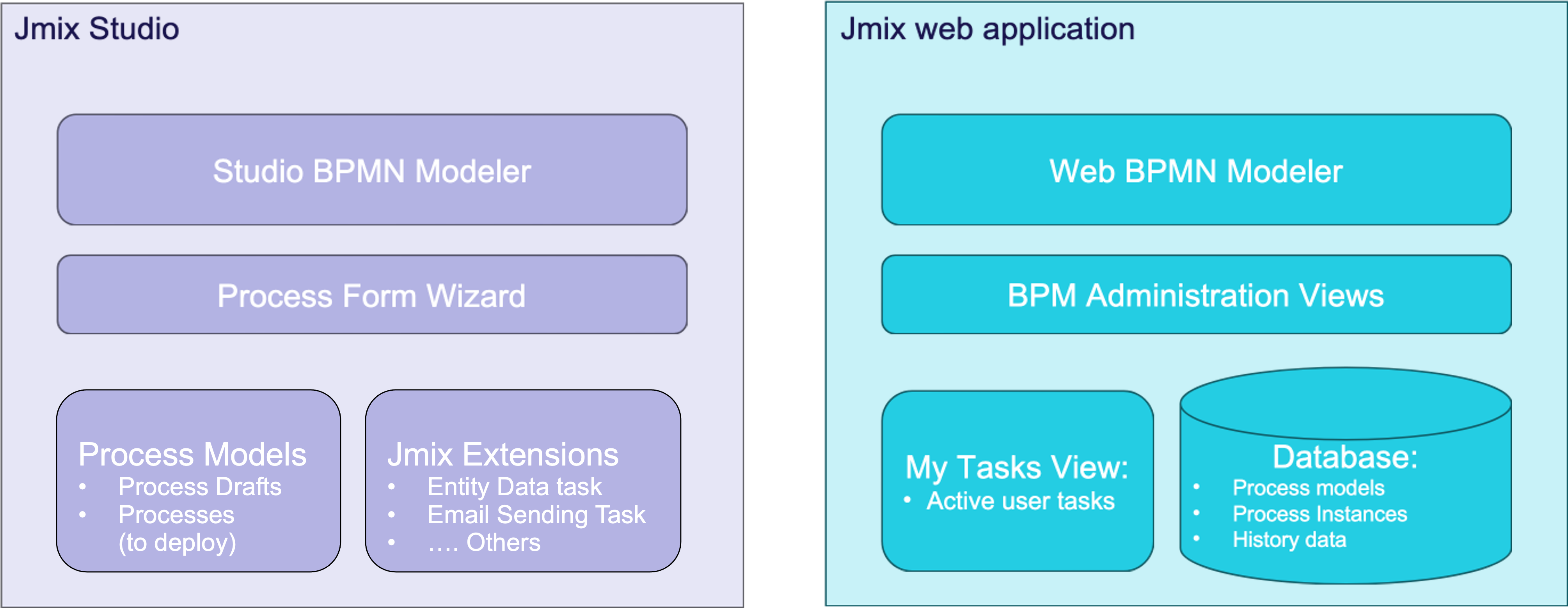Обзор возможностей
Дополнение BPM превращает Jmix в платформу для автоматизации и оркестрации бизнес-процессов, с помощью которой вы можете реализовать любые сложные сценарии взаимодействия людей и систем. Это достигается за счет интеграции в платформу Jmix open-source BPM движка Flowable, а также инструментов для проектирования, мониторинга и администрирования процессов.
Инструменты
Дополнение Jmix BPM внедряет новые инструменты для веб-приложения и Jmix Studio:
-
В запущенном приложении доступен моделер процессов в виде специального экрана, а также экраны для управления процессами.
-
В Studio разработчику доступен встроенный моделер процессов, визард создания процессных форм и BPM секция в Окне Инструментов Jmix.

BPM-движок Flowable
Jmix BPM использует движок управления бизнес-процессами Flowable. Данный движок является форком Activiti, сохраняет его сильные стороны, одновременно предлагая новые возможности. Flowable написан на Java и поддерживает стандарты BPMN 2.0, CMMN и DMN, что обеспечивает возможность создания адаптивных и эффективных бизнес-процессов.
| Jmix BPM не поддерживает CMMN. |
Стандарт BPMN 2.0
Jmix BPM придерживается широко распространенного стандарта BPMN 2.0. Спецификация BPMN 2.0 доступна на сайте Object Management Group: https://www.omg.org/bpmn/
Расширение набора задач
Дополнение Jmix BPM позволяет встраивать в процесс уникальные задачи и расширить возможности стандартных задач:
-
Entity Data Task – позволяет создавать, изменять и загружать сущности непосредственно из модели данных.
-
Email Sending Task – позволяет отправлять электронные письма как часть процесса.
-
User Providers – позволяет программно назначить исполнителя и кандидата для задачи.
-
Jmix BPM Spring Events – упрощает реализацию слушателей для событий процесса.
Конфигурация базы данных
Таблицы базы данных необходимые для работы создаются автоматически при установке дополнения. Они будут размещены в базе которая подключена к основному хранилищу.
Имена таблиц
Имена таблиц начинаются с ACT_, что отсылает к продукту Activiti форком которого является Flowable. Вторая часть имени состоит из двух символов, которые обозначают назначение данных, хранящихся в таблице.
-
ACT_RE_: Таблицы с префиксом RE (Repository) содержат 'статическую' информацию, такую как определения процессов и необходимые ресурсы процессов (изображения, правила и т. д.).
-
ACT_RU_: Таблицы с префиксом RU (Runtime) содержат данные о процессах, пользовательских задачах, переменных, заданиях и так далее. Flowable хранит данные во время выполнения экземпляра процесса и удаляет записи, когда экземпляр процесса завершается. Это позволяет поддерживать Runtime таблицы небольшими и быстрыми.
-
ACT_HI_: Таблицы с префиксом HI (History) содержат исторические данные, такие как прошлые экземпляры процессов, переменные, задачи и так далее. Когда данные удаляются из Runtime таблиц, эти таблицы по-прежнему содержат всю информацию для завершенных экземпляров.
-
ACT_GE_: Таблицы GE (General) содержат различные общие данные.
Роли пользователей
Дополнение интегрировано с подсистемой безопасности Jmix. Для работы с процессами в дополнение предусмотрено две ресурсные роли пользователей:
-
BPM: administrator – для административных задач и доступа ко всем экранам доступным в дополнении.
-
BPM: process actor – для участия в бизнес-процессах.
Дополнительные возможности
Возможности приложения можно расширить если использовать Jmix BPM совместно с другими дополнениями:
-
Quartz – позволяет планировать запуск процессов по расписанию.
-
Business calendar – возможность учитывать рабочие часы участников процесса.
-
Notifications – отправка in-app уведомлений участникам процесса и контролирующим лицам. Подробнее в разделе Sending Notifications.
-
Email Sending – отправка электронных писем. Подробнее в разделе Email Sending Task.
-
Reports – построение отчетов на основе оперативных данных и статистики исполнения процессов.